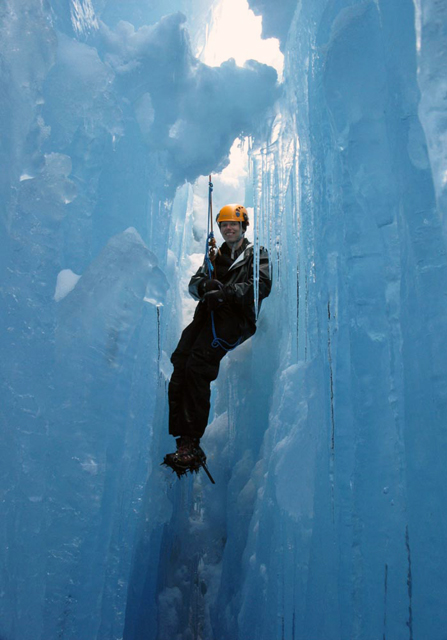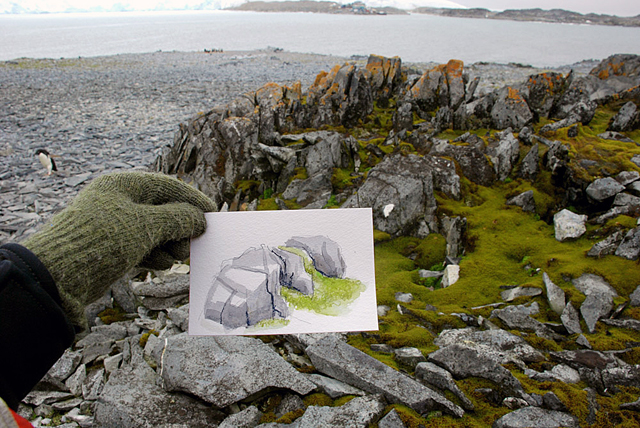Ice structuresSculptor finds parallels between natural forms and architectural installationsPosted July 17, 2009
Oona Stern describes her transformation from a painter to a sculptor as something of an epiphany, as she tried to evoke three-dimensional forms using a two-dimensional medium. “Why am I painting them? Why not just use material?” she explains, adding that she quickly eschewed traditional materials for what she could find in a hardware store. “Home Depot became my art supply store,” she says. “I use a lot of pre-fab, commercial and industrial material, and it’s appropriate to the content of my work, which is often about architecture and materials in architecture — how things have evolved in both suburban and urban contexts.” For instance, in one installation, a patio platform snakes through a large, multi-paned glass door, its paving stones and grass actually constructed from wood decking and carpet. Rectangular cuts of hedging resemble a brick wall in another installation, an explicit icon of how people use plants as walls to separate space. “I’m interested in the work being part of the everyday, so artwork isn’t so specialized. You don’t [have to] go to a museum for art. You don’t have to be a rich collector. It can just be part of your ordinary experience,” she says of her architectural installations. “It is about the context. … One of the functions of art is to get you to think.” On the surface, then, there’s not much to suggest what might interest the New York-based artist in Antarctic ice. Urban? There are no traffic lights, let alone roads. Suburban? No track housing in Antarctica. Everyday? Antarctica is unlike any place in the world. But Stern spent more than a month at Palmer Station
Yet she points that her interest in architectural form has parallels, even if the appropriate context still eludes her only a few months back in the studio, as she looks over the thousands of photos she took and the hundred or so drawings she sketched. “To me, ice is a structure, and it was my interest in structure which drew me to study massive forms of ice,” she notes. Stern says she was particularly interested in observing ice in all of its evolving forms, from calving icebergs to dripping icicles in a crevasse. A study of these would inform her understanding of the underlying structure. “I felt like I was a scientist, recording data about the ice and about the environment and about the light and about the sound,” she says. “But recording it as an artist, so that when I got back I would use that data to build my work.” The seeds of that work seem to be her notebook illustrations, scores of drawings that run from naturalistic to abstractionist. A mostly black and white illustration of brash ice — a patch of fragmented ice — looks like a shattered geometric puzzle. Other drawings capture a series of vertical and horizontal lines, what Stern refers to as “glacier plaid.” “Drawing for me is learning,” Stern says. “The drawing gets me to understand what I’m seeing in the first place.” It’s a process, she says, that mirrors how earlier scientists digested and then explained the natural world. “In a way, I’m following in the footsteps of these naturalists, who in order to understand the science, or physiology of something, drew [it].” Stern’s fieldwork took her to neighboring islands with her fellow artist-in-residence, Cheryl Leonard Stern says she found inspiration in artificial space as well, particularly the life-saving paraphernalia scattered about the station’s buildings. Her sketches include rolled up fire hoses and life preservers.
“That was very much part of the story, too,” she says. “Without the station being there, and all of the protocols and all of the support services, I couldn’t go off and be lowered down a crevasse.” Stern anticipates creating a series of works over the next several years, starting with some large-scale posters, sort of like wallpaper — blown-up versions of her “glacier plaid” drawings, for example. She also anticipates exhibiting the field drawings en mass, from the ice sketches to the drawings of the station safety equipment that made her trip possible. The sculptural installations will come later. For now, they exist as small lumps of clay, what Stern calls her “tabletop icebergs.” “It’s too big of a leap to do something on a large scale, and to work on a very intimate scale is a good place to start,” she says, finding her inspiration in this approach at the other end of the world, in the artwork of the Arctic’s Inuit, whose small-scale artwork resonated with her own experiences. “I realize that when your environment is so grand and so intimidating, so awe-inspiring, to make something small is an honest way to have a relationship with nature because humans are so small and humble.” NSF-funded research in this story: Oona Stern, Antarctic Artists and Writers Program, Award No. 0739319, http://antarcticice.blogspot.com/ |



For USAP Participants |
For The Public |
For Researchers and EducatorsContact UsU.S. National Science FoundationOffice of Polar Programs Geosciences Directorate 2415 Eisenhower Avenue, Suite W7100 Alexandria, VA 22314 Sign up for the NSF Office of Polar Programs newsletter and events. Feedback Form |





